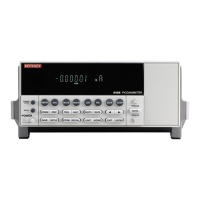13-6 DISPlay, FORMat, and SYSTem Model 6485 Picoammeter Instruction Manual
B) FORMat:ELEMents <item list>
Parameters READing = Current reading
UNITs = Units (always Amps)
TIME = Timestamp
STATus = Status information
The specified elements are included in the data string in response to :FETCh?, :READ?,
:MEASure? and :TRACe:DATA?. Note that each element in the item list must be sepa-
rated by a comma (i.e. send “:ELEMents READing, UNITs, TIME, STATus” to include
all elements in the data string. The elements for the ASCii format are shown in
Figure 16-1.
An overflow or overvoltage reading is returned as +9.9E37. When a specified data element
has invalid data associated with it, NAN (Not A Number) will be the response. NAN is
returned as +9.91E37.
Units — Units reference the returned readings units of measure. This will always be in
amps with the current reading in scientific notation.
Timestamp — Timestamp references the returned data string to a point in time. The
timestamp operates as a timer that starts at zero seconds when the instrument is turned on,
or when the timestamp is reset (SYSTem:TIME:RESet). After 99,999.99 seconds, the
timer resets to zero and starts over.
For buffer readings, timestamp can be referenced to the first reading stored in the buffer
(absolute format) which is timestamped at 0 seconds, or to the time between each stored
reading (delta format). The TRACe:TSTamp:FORMat command is used to select the
timestamp format.
Status — The status word provides information about Model 6485 operation. The 16-bit
status word is sent in decimal form. The decimal value has to be converted to the binary
equivalent to determine the state of each bit in the word. For example, if the returned status
value is 9, the binary equivalent is 00000001001. Bits 0 and 3 are set. The bits are
explained as follows:
Bit 0 (OFLO) — Set to 1 if measurement performed while in over-range (overflowed
reading).
Bit 1 (Filter) — Set to 1 when measurement performed with the averaging filter enabled.
Bit 2 (Math) — Set to 1 when measurement performed with CALC1 enabled.
Bit 3 (Null) — Set to 1 if null for CALC2 is enabled.
Bit 4 (Limits) — Set to 1 if a limit test (CALC2) is enabled.
Bits 5 and 6 (Limit Results) — Provides limit test results:

